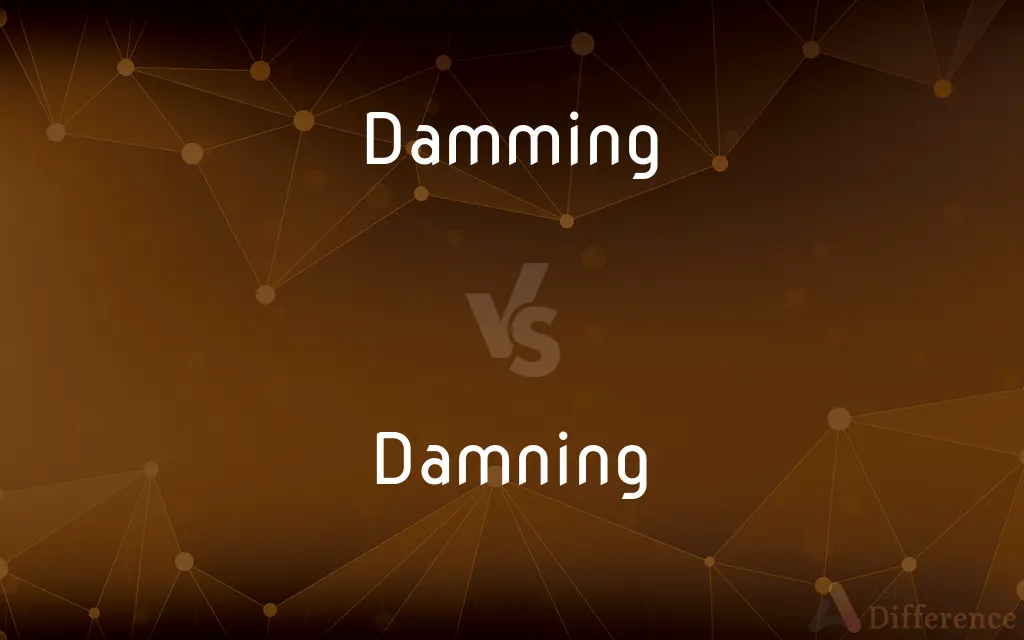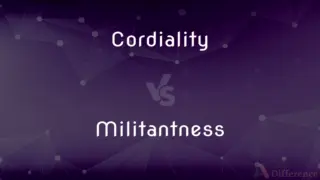Damming vs. Damning — What's the Difference?
Edited by Tayyaba Rehman — By Urooj Arif — Updated on April 8, 2024
Damming involves building barriers in waterways to control flow or create reservoirs, whereas damning means to condemn or criticize harshly.

Difference Between Damming and Damning
Table of Contents
ADVERTISEMENT
Key Differences
Damming is primarily an engineering and environmental activity, focusing on the construction of barriers across streams or rivers to control water flow, create reservoirs, or generate hydroelectric power. On the other hand, damning is a verbal action, often used metaphorically to express strong disapproval or condemnation of someone or something. The term can also imply a belief in assigning someone to eternal punishment in the afterlife.
While damming has tangible, physical impacts on ecosystems and human societies—altering water flow, affecting wildlife habitats, and enabling agricultural and urban development—damning operates in the realm of opinion and moral judgment. The consequences of damming can be seen and measured, such as changes in sediment transport or fish populations, whereas the effects of damning are more subjective, influencing reputations, public perceptions, and emotional states.
Damming requires significant planning, engineering expertise, and financial investment, reflecting a deliberate attempt to harness or modify natural forces for human benefit. Projects are typically undertaken by governments or large corporations and involve extensive environmental impact assessments.
Damning can be done by anyone capable of forming an opinion and expressing it. The act of condemning or denouncing doesn't require special skills or resources, making it accessible to individuals and groups across society. It can be spontaneous, driven by immediate reactions to perceived wrongs or injustices.
Comparison Chart
Definition
The act of building a dam across a watercourse.
The act of expressing strong disapproval or condemnation.
ADVERTISEMENT
Primary Purpose
To control water flow, generate power, or store water.
To criticize or condemn actions, ideas, or entities.
Physical/Abstract
Physical act involving construction and engineering.
Abstract act involving expression of judgment or disapproval.
Agents
Governments, corporations, and engineers.
Individuals, critics, or groups.
Outcomes
Changes in ecosystem, water availability, and landscape.
Influence on opinions, emotional responses, and reputations.
Compare with Definitions
Damming
A habitat alteration strategy for aquatic life.
Damming changes fish migration patterns and requires mitigation.
Damning
Condemning to eternal punishment.
The phrase to be damned often implies eternal punishment in religious contexts.
Damming
The process of constructing a dam to control water flow.
Damming the river will create a reservoir for the city.
Damning
A critical judgment impacting reputation.
Her damning testimony swayed public opinion.
Damming
A method to generate hydroelectric power.
Damming small rivers can provide local communities with energy.
Damning
A way to signify something as causing ruin or disaster.
Ignoring climate change warnings is damning for future generations.
Damming
An action aimed at water conservation and management.
The new damming project aims to improve irrigation.
Damning
Marking as guilty or unworthy.
The evidence was damning, leaving no doubt of the guilt.
Damming
An engineering effort to prevent floods.
Strategic damming along the coast protects the town from storm surges.
Damning
Expressing strong disapproval of someone or something.
The review was damning, calling the film a complete failure.
Damming
A barrier constructed across a waterway to control the flow or raise the level of water.
Damning
To condemn to everlasting punishment or another terrible fate in the afterlife; doom
"the ancient belief that souls of the deceased who had been damned for certain sins could rise from their graves and wander the countryside between dusk and dawn" (Rudy Chelminski).
Damming
A body of water controlled by such a barrier.
Damning
To condemn to an undesirable fate; destine
Was damned to live out his life in poverty.
Damming
A barrier against the passage of liquid or loose material, as a rubber sheet used in dentistry to isolate one or more teeth from the rest of the mouth.
Damning
To bring about the failure of; ruin
Insufficient funding damned the project.
Damming
To hold back or confine by means of a dam.
Damning
To denounce or criticize severely
A movie that was damned by the critics.
Damming
To close up; obstruct
He tried to dam his grief.
Damning
To swear at; curse.
Damming
Present participle of dam
Damning
To swear; curse.
Damming
The installation of a dam structure to block flow.
Damning
Used to express anger, irritation, contempt, or disappointment.
Damning
The saying of "damn" as a curse.
Damning
(Informal) The least valuable bit; a jot
Not worth a damn.
Damning
Damned.
Damning
Present participle of damn
Damning
Condemning.
Damning evidence was clear for all to see
Damning
A condemnation.
Damning
An act of swearing with the word "damn".
Damning
That damns; damnable; as, damning evidence of guilt.
Damning
Threatening with damnation
Common Curiosities
What are common purposes of damming?
Common purposes include flood control, irrigation, water storage, and hydroelectric power generation.
How does damming affect the environment?
Damming alters water flow, affects wildlife habitats, and can lead to significant ecological changes.
Can damning be positive?
Generally, damning is used in negative contexts to denote disapproval or condemnation.
What is damming?
Damming is the construction of barriers across waterways to control water flow or create reservoirs.
Who can engage in damning?
Anyone capable of expressing an opinion can engage in damning.
What does damning mean?
Damning refers to expressing strong disapproval or condemnation.
Who can perform damming?
Damming is typically carried out by governments or large corporations with the necessary resources.
Is damning a physical act?
No, damning is an abstract act involving expression of disapproval or judgment.
How does damning influence society?
Damning can shape public opinion, influence reputations, and impact social and political discourse.
What skills are required for damming?
Damming requires engineering, environmental planning, and project management skills.
Can damming have positive effects?
Yes, damming can provide benefits such as water supply, flood control, and renewable energy.
What are the social implications of damming?
Damming can lead to displacement of communities, changes in land use, and alterations in local economies.
Is damning always related to religion?
No, while it has religious connotations, damning is widely used in secular contexts to express condemnation.
Are there alternatives to damming for water management?
Yes, alternatives include water conservation practices, rainwater harvesting, and the use of decentralized, renewable energy sources.
How can the negative effects of damning be mitigated?
Through constructive criticism, open dialogue, and efforts to understand and address the underlying issues.
Share Your Discovery

Previous Comparison
Antisocial vs. Introverted
Next Comparison
Cordiality vs. MilitantnessAuthor Spotlight
Written by
Urooj ArifUrooj is a skilled content writer at Ask Difference, known for her exceptional ability to simplify complex topics into engaging and informative content. With a passion for research and a flair for clear, concise writing, she consistently delivers articles that resonate with our diverse audience.
Edited by
Tayyaba RehmanTayyaba Rehman is a distinguished writer, currently serving as a primary contributor to askdifference.com. As a researcher in semantics and etymology, Tayyaba's passion for the complexity of languages and their distinctions has found a perfect home on the platform. Tayyaba delves into the intricacies of language, distinguishing between commonly confused words and phrases, thereby providing clarity for readers worldwide.
















































